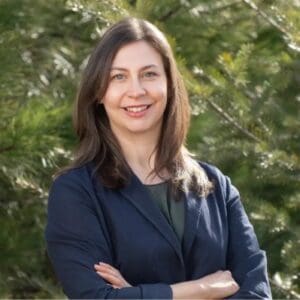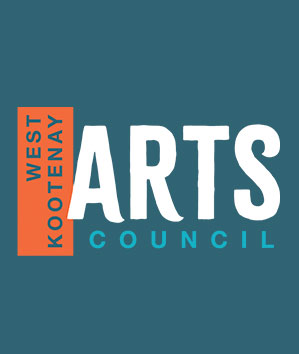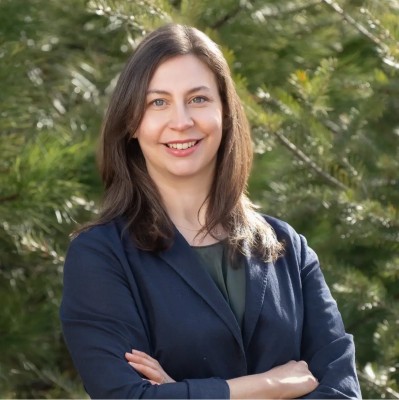Behind the Scenes: Q&A with Kallee Lins, WKRAC Staff Member

The West Kootenay Regional Arts Council (WKRAC) exists to help arts, culture and heritage in the Columbia Basin thrive. To do so, we rely on a dedicated team of board members, plus steering committee members who oversee the Columbia Kootenay Cultural Alliance (CKCA) arts and culture grants. We also have great employees!
Who are these people? In this series, we’re introducing you to the folks behind the scenes.
Kallee Lins, Executive Director
Based in Nelson, Kallee is celebrating her third anniversary at the helm of WKRAC.
WKRAC: When did you join WKRAC, and why did working here appeal to you?
KL: I started at WKRAC in June 2022. I was an avid dancer while growing up in the Kootenays, so as my experience in the cultural sector across Canada grew, I knew I wanted to play a role in strengthening the arts in my hometown and region. At the same time, my husband (born and raised in downtown Toronto) felt the pull of the mountains. When this job became available, it felt like the right moment to make the move (back) from Ontario to BC.
What are the main things you do in your position?
I love this post by E. Andrew Taylor that describes arts management as “the practice of aggregating and animating people, stuff, and money toward expressive ends.” As ED, I’m the person responsible for ensuring this happens in alignment with WKRAC’s strategic plan.
In practice, I spend a lot of time in dialogue with WKRAC’s funders, partners, and our board of directors. I write most of our grant applications, and oversee program design and delivery across both our flagship programs (CKCA, Articulate, Culture Tour), and strategic initiatives that vary from year to year. In a small organization like ours, I have to quickly toggle between high-level planning and business development, and more immediate tasks like website updates, managing mailing lists, building registration forms and more!
I’m also deeply passionate about arts advocacy and I do what I can to support communities across the Columbia Basin in making the case for greater investment in arts and culture.
How did you come to call the Columbia Basin home?
I’m a proud Castlegarian. It was wonderful to grow up in Castlegar. I’m glad I took the opportunity to study and work in other provinces, specifically Quebec and Ontario, but it’s great to be back in beautiful British Columbia. I truly love big cities, but I do not miss Toronto’s humidity!
Are you involved in arts, culture and heritage outside of your work with WKRAC/CKCA? If so, what is your discipline or practice?
I’ve always been a dancer. Until 2019, I was active on and off in contemporary dance collectives that gave me the chance to train, perform and choreograph. I dipped my toe into tango when I moved to Nelson, which I unexpectedly loved. I’m looking forward to getting back to contemporary dance this summer.
I also love serving other arts organizations through board work. I’m the board president for the Dance West Network and an inaugural board member for the Black & Rural Arts and Culture Society, supporting the fantastic work of Shayna Jones. I also try to stay connected to cultural conversations across the country; that was a big impetus for starting my weekly Substack Culturally Radical.
What do you think people in the region should be proud of in terms of arts, culture and heritage?
It’s rare to find such a wide range of aesthetics in one place. For art-goers, there is something for everyone, and there are so many opportunities to try out and practice a new art form in a welcoming environment.
I encourage everyone who loves the arts to speak constantly about the benefits the arts bring to communities. From an economic perspective alone, our sector is a major employer. One in every 27 workers in the Columbia Basin has a cultural job. Nationally, the contribution of culture to GDP ($73 billion) is on par with the oil and gas sector ($71 billion) and far outstrips the combined GDP of agriculture, forestry, fishing, and hunting ($41 billion) according to comparisons by Hill Strategies based on 2022 Statistics Canada data. Let’s own our power!
What advice do you have for people in the region pursuing a career in arts, culture and heritage?
There is always room for your unique thing. Don’t wait for public funding or validation from other “official” bodies to start testing your ideas and sharing them. I love to see works-in-progress and experimental pieces. Don’t get bogged down by what seems like the “right” way to create.
If you’re interested in management stuff, join a board! You’ll meet great people and learn so much about the ins and outs of nonprofits. I know how to do the work of an ED because I joined boards early in my career where I had the pleasure to learn from some of the best cultural managers and programmers in the country. (And if you already sit on a board, please invite youth to the table.)
Don’t be afraid to ask someone if they’d like to grab a coffee and talk about their work. Professionals in this space love what they do. Ask us about it. 😊
What vision do you see for the future of arts, culture and heritage in the Columbia Basin?
I see broad recognition of the value the arts bring to communities. I see the cultural sector being recognized as the economic and social development driver that it is, and I see consideration of the sector being woven through every municipal planning process across the region.
Anything else you’d like to add?
When I look at who is leading conversations about climate change, inequality, discrimination and more, artists are always at the table. We need creativity and the arts more than ever, yet there has also never been a harder time to be an artist. We have the data about how financially challenging it is to work in the arts in this region. If the arts are important to you, speak up. Tell your local, provincial and federal representatives, and anyone who will listen, that investments in the arts benefit all of us.

